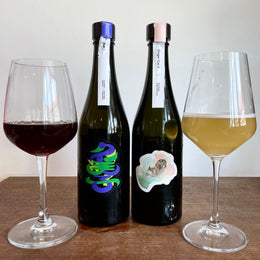
There’s a reason that umeshu fans perk up when they see that a bottle of umeshu has been made from “Nanko Ume”.
Ume refers generally to a type of Japanese plum that is a vital ingredient in making umeshu, which is Japanese plum wine. Yet, not all umes are created equal, and among all the umes, Nanko ume is often widely recognized as a best variety to make umeshu with. This is because all ume fruits generally have the same sized seeds, and so the best umes tend to be larger in size, as that means they have more flesh and meat.
To that end, Nanko umes are known for having thin skins, thicker and softer meat, and smaller seeds, making them particularly attractive input ingredients for umeshu breweries. Not only are Nanko umes sweet with a peach-like aroma, they also carry higher citrate and antioxidant content. This is what contributes to a delicious tanginess in an umeshu, and gives it an ideal balance of sweet and sour that umeshu fans covet.
If you’re wondering how it got its name, Nanko ume was actually named after a high school in the Wakayama prefecture, called Minabe High School (abbreviated as Nanko). Back in the 1950s, a teacher at the horticulture department of the school, Mr Katsutaro Takenaka, was tasked by a local committee to select the most superior ume variety out of more than 114 types of ume that were being grown in the region at that time. The final triumphant variety selected as the best of the best was named Nanko Ume in recognition of Takenaka’s efforts.


Nanko umes are characterised by their distinct red tinge. (Image source: Shun Gate)
These days, Nanko ume is grown in the Wakayama prefecture in Japan, which unsurprisingly, now accounts for around 60% of total ume production in the country. You can recognize it by its very distinctive red-tinged skin. If you’re ever visiting the Wakayama prefecture, be sure to make a stop at the Minabe Town, where it is said that “you can see millions of ume trees and enjoy the fragrance from twenty miles away”.
For now though, I am in Singapore and far more than twenty miles away from Minabe. So I do the best I can to find other ways to enjoy the fragrance of ume, primarily by drinking whatever umeshu I can get my hands on. My treat for today is a Kishu Pineapple Umeshu from Nakano BC, made in Wakayama from purely Nanko ume fruits.
According to Nakano BC, Nanko Ume is sourced from local farmers and brought to their umeshu brewery, where it is steeped in sake spirit for six months until the ume and the liquid, which becomes the umeshu, separate. The umeshu is then aged for at least half a year more for the flavors, aromas and colors to deepen. At this point, pineapple fruit juice is blended into the aged mixture, and bottled to become the Kishu Pineapple Umeshu I have in my hands today.
Kishu Pineapple Umeshu – Tasting Notes

Nose: Fizzy ginger ale, fresh pineapple peels, cloudy apple juice.
Palate: It begins with a very sweet, sharp bouquet of apple, pineapples and plum. The puckering sweetness is first reminiscent of lollipops and hard candy, but then it quickly evolves with more sourness poking through. Now, it starts to reminds me of warheads or sour strips – still sweet but now with a slightly more ideal balance.
Finish: Whereas the palate was sweet-sour, the finish takes on a slight bitter note. Here, the pineapple candy note changes into one of bitter pineapple peels. It has a slight fermented quality to it that reminds me of tepache. There’s a slightly herbal quality to it, almost like the after taste of a Campari shot. I also get a very light warming spice note of cinnamon that adds complexity to the bitter pineapple peel note.
My Rating:
🤏🏻🎟
It veers thiiiiiiisss close to being a too sweet, but the slight sourness and bitterness that kicks in near the finish invites some complexity back into it. If you can’t afford to fly to Wakayama, this still offers a ticket to try Nanko ume in action.
You can purchase a bottle of this Kishu Pineapple Umeshu at Orihara at 11 Unity Street in Singapore.







